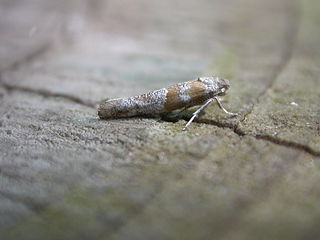| Atemelia | |
|---|---|
| Scientific classification | |
| Kingdom: | |
| Phylum: | |
| Class: | |
| Order: | |
| Family: | |
| Subfamily: | |
| Genus: | Atemelia Herrich-Schäffer, 1853 |
| Species | |
See text | |

Atemelia is a genus of moths of the family Plutellidae.
| Atemelia | |
|---|---|
| Scientific classification | |
| Kingdom: | |
| Phylum: | |
| Class: | |
| Order: | |
| Family: | |
| Subfamily: | |
| Genus: | Atemelia Herrich-Schäffer, 1853 |
| Species | |
See text | |

Atemelia is a genus of moths of the family Plutellidae.

Yponomeutoidea is a superfamily of ermine moths and relatives. There are about 1,800 species of Yponomeutoids worldwide, most of them known to come from temperate regions. This superfamily is one of the earliest groups to evolve external feeding and to colonize herbs in addition to shrubs and trees.

The Plutellidae are a family of moths commonly known as the diamondback moths, named after the diamondback moth of European origin. It was once considered to have three subfamilies: Plutellinae, Praydinae, and Scythropiinae. Praydinae was later elevated to its own family, Praydidae, while Scythropiinae has variously been moved to Yponomeutidae or also elevated to its own family.

Cedestis gysseleniella is a moth of the family Yponomeutidae. It is found in Europe and parts of Russia.

Prays is a genus of moths of the family Praydidae, formerly assigned to Plutellidae or Yponomeutidae.
Paraargyresthia is a genus of moths of the family Yponomeutidae.
Distagmos is a genus of moths of the family Plutellidae.
Prays amblystola is a species of moth in the family Praydidae. It was described by Alfred Jefferis Turner in 1923 and is found in New South Wales, Australia.
Prays calycias is a species of moth in the family Praydidae. It was described by Edward Meyrick in 1907 and is found in Australia.
Prays inscripta is a species of moth in the family Praydidae. It was described by Edward Meyrick in 1907 and is found in Australia. The larvae feed on Phebalium plants.
Prays ducalis is a species of moth in the family Praydidae. It was described by English entomologist Edward Meyrick in 1914 based a single specimen collected in Sri Lanka.
Prays endolemma is a species of moth in the family Praydidae. It was described by Alexey Diakonoff in 1967 and is found on the island of Luzon in the Philippines.
Prays erebitis is a species of moth in the family Praydidae. It was described by English entomologist Edward Meyrick in 1914 based on two specimens collected in Ootacamund, India.
Prays chrysophyllae is a species of moth in the family Praydidae. It was described by Italian entomologist Filippo Silvestri in 1915 and is known from Eritrea. The larvae feed on wild olive.
Prays friesei is a species of moth in the family Praydidae. It is found on the Canary Islands and Madeira. The larvae feed on Chrysojasminum odoratissimum and Picconia excelsa.
Prays fulvocanella is a species of moth in the family Praydidae. It is endemic to the Hawaiian island of Kauai. Species of Melicope and Zanthoxylum may serve as hosts for P. fulvocanella larvae.
Prays liophaea is a species of moth in the family Praydidae. It was described by English entomologist Edward Meyrick in 1927 based on two specimens collected from Stellenbosch, South Africa.
Prays peperitis is a species of moth in the family Praydidae. It was described by English entomologist Edward Meyrick in 1907 based on seven specimens collected in Sri Lanka.
Prays xeroloxa is a species of moth in the family Praydidae. It was described by English entomologist Edward Meyrick in 1935 based on larvae collected from the island of Java and reared on Harrisonia leaves.

Praydidae is a family of false ermine moths in the superfamily Yponomeutoidea. Though once considered a subfamily (Praydinae), a 2013 molecular analysis elevated it to family rank.
Prays omicron is a moth of the family Praydidae. It is found in Japan.